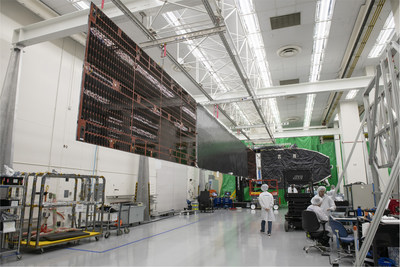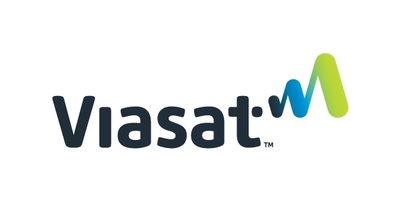ViaSat-3 Achieves Flight Configuration
Viasat (NASDAQ: VSAT) announced the successful completion of the first ViaSat-3 satellite's integration into its flight configuration, marking a significant milestone in satellite communications. The satellite will undergo mechanical environmental testing to simulate launch conditions. Its reflectors and solar arrays, among the largest ever sent to space, contribute to a total wingspan of 144 feet. The ViaSat-3 class satellites aim to deliver effective bandwidth economics and coverage across the Americas, EMEA, and Asia Pacific. The launch is anticipated later this year.
- Completion of ViaSat-3 satellite integration into flight configuration.
- Large reflectors and solar arrays enhance satellite capabilities.
- Expected to offer superior bandwidth economics in the industry.
- Potential risks associated with launch, including operational failures or delays.
Insights
Analyzing...
Milestone Marks Completion of Satellite's Mechanical Environments Build Process
CARLSBAD., Calif., Sept. 29, 2022 /PRNewswire/ -- Viasat Inc. (NASDAQ: VSAT), a global leader in satellite communications, announced today the completion of the integration of the first ViaSat-3 satellite, marking the first time the satellite is in its flight configuration. The ViaSat-3 satellite has now entered the mechanical environmental testing process, simulating the vibration and acoustic environments that the satellite will experience during the launch and early transfer orbit phases of its mission, in preparation for launch later this year.
During the integration process, the solar arrays, reflectors and other items were attached to the satellite, bringing it to its full, flight configuration for the first time. The satellite's reflectors will be some of the largest ever sent to space, along with its solar arrays, each featuring eight panels with an overall wingspan of 144 feet, similar in size to that of a Boeing 767 airliner.
"This marks the first time our satellite is in flight configuration which is a huge milestone for our hard-working team and a major step to the deployment of the ViaSat-3 constellation," said Dave Ryan, president Space & Commercial Networks at Viasat. "This next phase of testing will confirm that our satellite can survive the rigors of launch and begin its mission as planned."
The ViaSat-3 class of Ka-band satellites is expected to provide the best bandwidth economics in the industry with substantial flexibility to move and concentrate that capacity virtually anywhere there is demand - whether it is on land, in the ocean or in the air. The first two satellites are planned to focus on the Americas and on EMEA, respectively, and the ViaSat-3 EMEA satellite is still undergoing integration at our spacecraft partner, Boeing. The third ViaSat-3 satellite is now undergoing final payload integration and testing at Viasat's Tempe, Arizona facility and will focus on the Asia Pacific region, completing Viasat's global service coverage.
This press release contains forward-looking statements that are subject to the safe harbors created under the Securities Act of 1933 and the Securities Exchange Act of 1934. Forward looking statements include among others, statements about the performance, capabilities and anticipated benefits of the ViaSat-3 class satellite platform, projected bandwidth economics, expected coverage, flexibility and other features of the ViaSat-3 constellation, and the timing of launch. Readers are cautioned that actual results could differ materially from those expressed in any forward-looking statements. Factors that could cause actual results to differ include: risks associated with the construction, launch and operation of the ViaSat-3 class satellites and Viasat's other satellites, including the effect of any anomaly, operational failure or degradation in satellite performance; the ability to realize the anticipated benefits of the ViaSat-3 satellite platforms; unexpected expenses or delays related to the satellite system; the ability to successfully implement Viasat's business plan for broadband satellite services on Viasat's anticipated timeline or at all, including with respect to the ViaSat-3 satellite platforms; contractual problems, product defects, manufacturing issues or delays; regulatory issues; technologies not being developed according to anticipated schedules, or that do not perform according to expectations; and increased competition and other factors affecting the connectivity sector, generally. In addition, please refer to the risk factors contained in Viasat's SEC filings available at www.sec.gov, including Viasat's most recent Annual Report on Form 10-K and Quarterly Reports on Form 10-Q. Readers are cautioned not to place undue reliance on any forward-looking statements, which speak only as of the date on which they are made. Viasat undertakes no obligation to update or revise any forward-looking statements for any reason.
Viasat is a global communications company that believes everyone and everything in the world can be connected. For more than 35 years, Viasat has helped shape how consumers, businesses, governments and militaries around the world communicate. Today, the Company is developing the ultimate global communications network to power high-quality, secure, affordable, fast connections to impact people's lives anywhere they are—on the ground, in the air or at sea. To learn more about Viasat, visit: www.viasat.com, go to Viasat's Corporate Blog, or follow the Company on social media at: Facebook, Instagram, LinkedIn, Twitter or YouTube.
Copyright © 2022 Viasat, Inc. All rights reserved. Viasat, the Viasat logo and the Viasat signal are registered trademarks of Viasat, Inc. All other product or company names mentioned are used for identification purposes only and may be trademarks of their respective owners.
![]() View original content to download multimedia:https://www.prnewswire.com/news-releases/viasat-3-achieves-flight-configuration-301636343.html
View original content to download multimedia:https://www.prnewswire.com/news-releases/viasat-3-achieves-flight-configuration-301636343.html
SOURCE Viasat, Inc.









